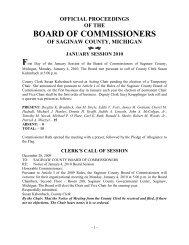The Metropolitan Transportation Planning ... - Saginaw County
The Metropolitan Transportation Planning ... - Saginaw County
The Metropolitan Transportation Planning ... - Saginaw County
Create successful ePaper yourself
Turn your PDF publications into a flip-book with our unique Google optimized e-Paper software.
<strong>The</strong> <strong>Metropolitan</strong> <strong>Transportation</strong> <strong>Planning</strong> Process: Key Issues<br />
revising the SIP, which can be a complicated and lengthy process MPOs should<br />
participate in the SIP revision process if it is undertaken.<br />
What is a conformity determination and who makes it?<br />
National Ambient Air Quality Standards:<br />
<strong>The</strong> outdoor air in a given area, and its<br />
level of pollution. It is monitored<br />
according to two sets of criteria: A<br />
primary standard to protect public<br />
health, including the health of<br />
populations such as children, the elderly,<br />
and asthmatics; and a secondary<br />
standard to protect public welfare,<br />
including effects on soils, water, crops,<br />
vegetation, buildings, property, animals,<br />
wildlife, weather, visibility, transportation,<br />
and other economic values, as well as<br />
personal comfort and well-being.<br />
Regionally Significant Projects:<br />
Regionally significant projects serve<br />
regional transportation needs such as<br />
access to and from the major activity<br />
centers in the region, and would<br />
normally be included in the modeling of<br />
a metropolitan area’s transportation<br />
network. <strong>The</strong>se projects include, at a<br />
minimum, all principal arterial highways<br />
and all fixed-guideway transit facilities.<br />
<strong>Transportation</strong> conformity on transportation plans and TIPs is demonstrated when<br />
projected regional emissions for the Plan and TIP do not exceed the region’s motor<br />
vehicle emissions budgets. A conformity determination is a finding by the MPO<br />
policy board, and subsequently by FHWA and FTA, that the transportation plan and<br />
TIP meet the conformity requirements. While the MPO is ultimately responsible for<br />
making sure a conformity determination is made, the conformity process depends<br />
on federal, state, and local transportation and air quality agencies working<br />
together to meet the transportation conformity requirements. If transportation<br />
control measures (TCMs) are part of the SIP, the MPO must provide an assurance<br />
that TCMs are being implemented on schedule each time it updates its plan and<br />
TIP.<br />
If transportation control measures (TCMs) are part of the SIP, the MPO must provide<br />
an assurance that TCMs are being implemented on schedule each time it updates<br />
its plan and TIP.<br />
A necessary part of the transportation and air quality planning process is consulting<br />
with other involved agencies on critical issues and providing opportunities for public<br />
participation. MPOs must inform the public that they are going to make a<br />
conformity determination, make all relevant documents reasonably available, and<br />
give adequate time to review the documents and supporting materials.<br />
What plans, programs, and projects are subject to transportation<br />
conformity requirements?<br />
<strong>The</strong> MPO’s 20-year transportation plan and TIP must meet the conformity<br />
requirements. This includes all projects that are expected to be funded or that will<br />
require an approval by FHWA/FTA at any point during the life of the plan or TIP.<br />
Also, any regionally significant projects (as defined by the conformity rule), even<br />
those that are not federally funded or approved, must be included in the regional<br />
emissions analysis of the transportation plan and TIP. Regionally significant projects<br />
include at a minimum, all principle arterial highways and all fixed-guideway transit<br />
facilities.<br />
Finally, certain projects in CO and PM nonattainment and maintenance areas must<br />
be assessed for expected concentration levels ("hot spots") of carbon monoxide<br />
and particulates.<br />
How frequently must a transportation conformity determination be<br />
made and what happens if the MPO cannot make a conformity<br />
determination on time?<br />
A conformity determination must be made on the transportation plan and TIP at<br />
least once every three years. Each time the MPO updates its transportation plan or<br />
its TIP (except for minor amendments), a conformity determination is required. A<br />
conformity determination is also required not more than 18 months after a SIP or a<br />
SIP revision is approved or found adequate by EPA.<br />
If an MPO cannot meet the transportation conformity requirements (i.e., is in a<br />
conformity lapse), then only certain types of projects may proceed until the<br />
requirements are met.


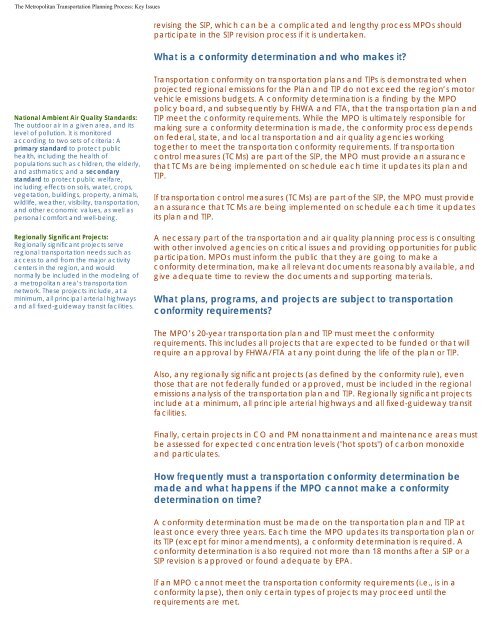
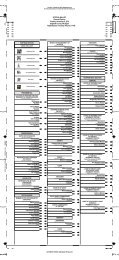
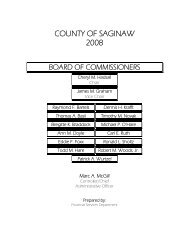
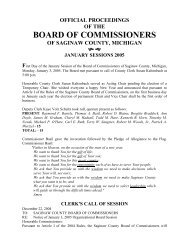
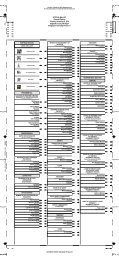

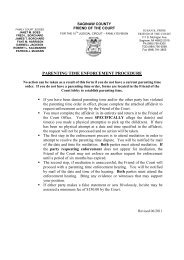
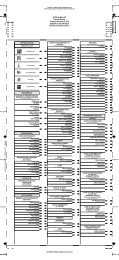


![[ Of Commissioners] - Saginaw County](https://img.yumpu.com/25951211/1/190x245/-of-commissioners-saginaw-county.jpg?quality=85)


